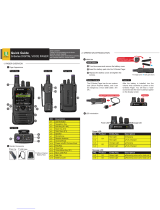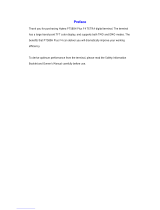Page is loading ...

ST7000 Product
Information Manual
MOBILE RELEASE 16.0
*MN002955A01*
MN002955A01-AA
OCTOBER 2016
© 2016 Motorola Solutions, Inc. All rights reserved


Copyrights
The Motorola Solutions products described in this document may include copyrighted Motorola
Solutions computer programs. Laws in the United States and other countries preserve for Motorola
Solutions certain exclusive rights for copyrighted computer programs. Accordingly, any copyrighted
Motorola Solutions computer programs contained in the Motorola Solutions products described in this
document may not be copied or reproduced in any manner without the express written permission of
Motorola Solutions.
©
2016 Motorola Solutions, Inc. All Rights Reserved
No part of this document may be reproduced, transmitted, stored in a retrieval system, or translated
into any language or computer language, in any form or by any means, without the prior written
permission of Motorola Solutions, Inc.
Furthermore, the purchase of Motorola Solutions products shall not be deemed to grant either directly
or by implication, estoppel or otherwise, any license under the copyrights, patents or patent
applications of Motorola Solutions, except for the normal non-exclusive, royalty-free license to use that
arises by operation of law in the sale of a product.
Disclaimer
Please note that certain features, facilities, and capabilities described in this document may not be
applicable to or licensed for use on a particular system, or may be dependent upon the characteristics
of a particular mobile subscriber unit or configuration of certain parameters. Please refer to your
Motorola Solutions contact for further information.
Trademarks
MOTOROLA, MOTO, MOTOROLA SOLUTIONS, and the Stylized M Logo are trademarks or
registered trademarks of Motorola Trademark Holdings, LLC and are used under license. All other
trademarks are the property of their respective owners.
European Union (EU) Waste of Electrical and Electronic Equipment (WEEE)
directive
The European Union's WEEE directive requires that products sold into EU countries must have
the crossed out trash bin label on the product (or the package in some cases).
As defined by the WEEE directive, this cross-out trash bin label means that customers and end-users
in EU countries should not dispose of electronic and electrical equipment or accessories in household
waste.
Customers or end-users in EU countries should contact their local equipment supplier representative or
service centre for information about the waste collection system in their country.
MN002955A01-AA
Copyrights
Send Feedback 3

This page intentionally left blank.

Contents
Copyrights................................................................................................................... 3
List of Figures............................................................................................................. 9
List of Tables.............................................................................................................11
Icon Conventions......................................................................................................13
Chapter 1: Product Overview...................................................................................15
1.1 ST7000 Overview..................................................................................................................15
1.1.1 ST7000 Specifications.............................................................................................16
1.2 Ordering Options for Radios and Features............................................................................17
1.3 Radio Ordering...................................................................................................................... 18
1.4 Customer Programming Software......................................................................................... 18
Chapter 2: Services and Features........................................................................... 19
2.1 System Support.....................................................................................................................19
2.2 Trunked Mode Operation.......................................................................................................19
2.3 Direct Mode Operation...........................................................................................................20
2.4 Numbering and Addressing...................................................................................................20
2.5 Dialing Methods.....................................................................................................................21
2.5.1 Individual Dialing......................................................................................................21
2.6 Unified Address Book............................................................................................................21
2.7 Group Call..............................................................................................................................22
2.7.1 Programmable Talkgroups.......................................................................................22
2.7.2 Talkgroup Folders....................................................................................................22
2.7.3 Talkgroup Selection.................................................................................................23
2.7.4 Favorite Folders.......................................................................................................23
2.7.5 Receive-only Talkgroups......................................................................................... 24
2.7.6 Non-Selectable Talkgroups......................................................................................24
2.7.7 Transmission Timeout Timer................................................................................... 24
2.7.8 Group Call Reception...............................................................................................24
2.7.9 Talkgroup Scanning.................................................................................................24
2.7.10 Priority Monitor.......................................................................................................25
2.7.11 Timed Talkgroup Change...................................................................................... 25
2.7.12 Broadcast Call........................................................................................................26
2.7.13 PTT Double Push...................................................................................................26
2.7.14 PTT Queue............................................................................................................ 27
2.7.15 Talking Party Identification.....................................................................................27
2.7.16 Call Ownership.......................................................................................................27
MN002955A01-AA
Contents
Send Feedback 5

2.7.17 Transmission During Group Call............................................................................27
2.7.18 Call Restoration..................................................................................................... 27
2.7.19 Temporary Group Address.................................................................................... 27
2.7.20 Late Entry...............................................................................................................27
2.7.21 User Initiated Group Attachment............................................................................28
2.8 Private Call............................................................................................................................ 28
2.8.1 Simplex Private Call.................................................................................................29
2.8.2 Duplex Private Call.................................................................................................. 29
2.8.3 Transmission Timeout Timer................................................................................... 29
2.8.4 Call Restoration in Private Call................................................................................29
2.8.5 Call Modification.......................................................................................................29
2.8.6 DMO Individual Call Presence Check......................................................................30
2.8.7 DMO Individual Only Talkgroups.............................................................................30
2.8.8 Private Calls through DMO Gateway.......................................................................30
2.9 Phone Call.............................................................................................................................30
2.9.1 Phone Call Initiation.................................................................................................31
2.9.2 Phone Call Reception..............................................................................................31
2.9.3 Call Restoration in Phone Call.................................................................................31
2.10 Emergency Operations........................................................................................................31
2.10.1 Emergency Group Call...........................................................................................32
2.10.2 Non-Tactical Emergency........................................................................................32
2.10.3 Emergency Alarm.................................................................................................. 33
2.10.4 Emergency SDS Status.........................................................................................33
2.10.5 Emergency Hot Microphone.................................................................................. 33
2.10.6 Alternating Hot Microphone................................................................................... 33
2.10.7 Invisible Emergency...............................................................................................34
2.11 Security Services.................................................................................................................34
2.11.1 Terminal Equipment Identity..................................................................................34
2.11.2 Authentication........................................................................................................34
2.11.3 Radio Disable or Enable........................................................................................34
2.11.4 Radio Permanent Disable......................................................................................35
2.11.5 Radio Permanent Disable v2.................................................................................35
2.11.6 High Assurance Boot.............................................................................................36
2.12 Packet Data.........................................................................................................................36
2.12.1 Voice and Data Support.........................................................................................37
2.12.2 Packet Data IP Addressing....................................................................................38
2.12.3 Packet Data User Authentication...........................................................................38
2.13 TETRA Network Protocol 1..................................................................................................38
2.13.1 TETRA Network Protocol 1 IP Addressing............................................................ 39
MN002955A01-AA
Contents
6 Send Feedback

2.14 Mobility Services..................................................................................................................39
2.14.1 Main Control Channel Frequencies....................................................................... 39
2.14.2 Control Channel Selection.....................................................................................40
2.14.3 Registration............................................................................................................40
2.14.4 Call Roaming......................................................................................................... 41
2.14.5 Seamless Handover...............................................................................................42
2.14.6 Congested Cell Handling.......................................................................................42
2.14.7 Subscriber Class....................................................................................................42
2.14.8 Subscriber Class by Talkgroup..............................................................................42
2.14.9 RF Power Class Toggle.........................................................................................43
2.14.10 Local Site Trunking..............................................................................................43
2.14.11 Cell Surveillance and Monitoring Threshold (Negative C)...................................44
2.15 Supplementary Services......................................................................................................44
2.15.1 Dynamic Group Number Assignment.................................................................... 44
2.15.2 Ambience Listening................................................................................................46
2.15.3 Pseudo Power-Off..................................................................................................46
2.15.4 Preemptive Priority Call......................................................................................... 46
2.15.5 Transmit Inhibit Mode............................................................................................ 47
2.15.6 Calling Line Identification Presentation..................................................................47
2.15.7 Universal Time Display..........................................................................................48
2.16 DMO Gateway and Repeater Communication.................................................................... 48
2.16.1 Communication through Repeaters.......................................................................49
2.16.2 Communication through Gateways........................................................................49
2.16.3 Gateway and Repeater Synchronization............................................................... 50
2.17 SDS Remote Control...........................................................................................................50
2.18 Status Remote Control........................................................................................................ 51
2.19 Global Navigation Satellite System (GNSS) Location Service............................................ 52
2.19.1 Global Navigation Satellite System (GNSS) over Packet Data..............................54
2.19.2 Global Navigation Satellite System (GNSS) Accuracy.......................................... 55
2.19.3 Location Report Backlog........................................................................................55
2.20 Bluetooth..............................................................................................................................55
2.20.1 Bluetooth Interactions............................................................................................56
2.20.2 Bluetooth Restrictions............................................................................................56
2.20.3 Bluetooth Sensor Data...........................................................................................57
2.20.4 Bluetooth Smart Proximity Pairing.........................................................................57
Chapter 3: Man-Machine Interface...........................................................................59
3.1 LED Indications......................................................................................................................59
3.2 Battery Charging Indications..................................................................................................60
3.3 Controls and Indicators..........................................................................................................60
MN002955A01-AA
Contents
Send Feedback 7

3.4 One-Touch Buttons................................................................................................................62
3.5 Display...................................................................................................................................63
3.5.1 Status Icons.............................................................................................................64
3.5.2 Idle Display.............................................................................................................. 65
3.5.3 Languages Supported..............................................................................................66
3.6 Tones.....................................................................................................................................67
3.7 Description of Tones..............................................................................................................68
3.8 Dual Microphones..................................................................................................................68
3.9 Audio Toggle..........................................................................................................................69
3.10 Volume Adjustment Mode....................................................................................................69
3.11 Accessory Setup..................................................................................................................69
3.12 Audio Features.................................................................................................................... 69
3.12.1 Audio Profile...........................................................................................................69
3.13 Test Page............................................................................................................................ 70
3.14 Radio Info............................................................................................................................ 71
3.15 Hardware Test.....................................................................................................................71
Appendix A: Service Information – EIA.................................................................. 73
Appendix B: Service Information – AME................................................................ 75
Appendix C: Service Information – Americas........................................................ 79
MN002955A01-AA
Contents
8 Send Feedback

List of Figures
Figure 1: ST7000....................................................................................................................................15
Figure 2: Trunked Mode Operation........................................................................................................ 20
Figure 3: Direct Mode Operation............................................................................................................20
Figure 4: Talkgroup Tree........................................................................................................................23
Figure 5: Communication through Repeaters.........................................................................................49
Figure 6: Communication through Gateways.........................................................................................49
Figure 7: SDS Remote Control Overview...............................................................................................50
Figure 8: Charger Mode Screen.............................................................................................................60
Figure 9: Default Home Screen with Icons.............................................................................................64
MN002955A01-AA
List of Figures
Send Feedback 9

This page intentionally left blank.

List of Tables
Table 1: General Technical Specification...............................................................................................16
Table 2: RF Specification....................................................................................................................... 16
Table 3: Environmental Specification.....................................................................................................17
Table 4: Bluetooth Audio and Data Services..........................................................................................17
Table 5: Location Services.....................................................................................................................17
Table 6: Packet Data IP Addressing.......................................................................................................38
Table 7: TETRA Network Protocol 1 (TNP1) IP Addressing.................................................................. 39
Table 8: GNSS Triggers.........................................................................................................................53
Table 9: LED Status Indications.............................................................................................................59
Table 10: Battery Charging LED Indications.......................................................................................... 59
Table 11: Battery Icons...........................................................................................................................60
Table 12: One-Touch Button Features ..................................................................................................62
Table 13: Display....................................................................................................................................64
Table 14: Trunked Mode Operation (TMO) Icons...................................................................................64
Table 15: Direct Mode Operation (DMO) Icons......................................................................................64
Table 16: General Icons.........................................................................................................................65
Table 17: Languages Supported............................................................................................................66
Table 18: Radio Tones...........................................................................................................................67
Table 19: Service Information — Telephone Numbers to EIA Integrated Call Center........................... 73
Table 20: Service Information – Telephone Numbers and Addresses of the Asia and Pacific
Motorola Solutions Centers...............................................................................................................75
Table 21: Service Information – Telephone Numbers and Addresses of Latin America Radio
Support Centers................................................................................................................................ 79
Table 22: Service Information – Telephone Numbers and Addresses of Latin America Motorola
Solutions Centers..............................................................................................................................79
MN002955A01-AA
List of Tables
Send Feedback 11

This page intentionally left blank.

Icon Conventions
The documentation set is designed to give the reader more visual clues. The following graphic icons
are used throughout the documentation set.
DANGER: The signal word DANGER with the associated safety icon implies information that, if
disregarded, will result in death or serious injury.
WARNING: The signal word WARNING with the associated safety icon implies information that,
if disregarded, could result in death or serious injury, or serious product damage.
CAUTION: The signal word CAUTION with the associated safety icon implies information that,
if disregarded, may result in minor or moderate injury, or serious product damage.
CAUTION: The signal word CAUTION may be used without the safety icon to state potential
damage or injury that is not related to the product.
IMPORTANT: IMPORTANT statements contain information that is crucial to the discussion at
hand, but is not CAUTION or WARNING. There is no warning level associated with the
IMPORTANT statement.
NOTICE: NOTICE contains information more important than the surrounding text, such as
exceptions or preconditions. They also refer the reader elsewhere for additional information,
remind the reader how to complete an action (when it is not part of the current procedure, for
instance), or tell the reader where something is on the screen. There is no warning level
associated with a notice.
MN002955A01-AA
Icon Conventions
Send Feedback 13

This page intentionally left blank.

Chapter 1
Product Overview
1.1
ST7000 Overview
The ST7000 is a compact and sophisticated TETRA radio, designed specifically for customer-facing
staffs, executives, and senior officers.
Figure 1: ST7000
The radio combines elegant and discreet design with a simple user interface and high-quality audio to
maintain the highest level of customer service. Driven by style and function, the ST7000 radio is a
communications tool that delivers the ergonomics of a smartphone without the associated distractions.
These intuitive features allow you to focus on the task at hand instead of on the radio, thus increasing
productivity at work.
With a hybrid internal and external antenna system, the ST7000 radio fits easily in a pocket. The touch
sensitive buttons, integrated Bluetooth
®
4.0 wireless technology, a reversible USB-C
™
connector for
charging, and 3.5 mm audio connector make the ST7000 radio a flexible, modern TETRA radio. The
ST7000 radio also provides uncompromising audio quality with low distortion, low audio power, and 1.8
W transmission power.
MN002955A01-AA
Product Overview
Send Feedback 15

1.1.1
ST7000 Specifications
The following tables explain the specifications of the ST7000 radio.
Table 1: General Technical Specification
Parameter Value
Dimensions H x W x D mm 107 x 60 x 19
122 x 60 x 19 (radio with 800 MHz antenna)
132 x 60 x 19 (radio with 380–430 MHz antenna)
Weight g 181 (radio with battery and antenna)
Battery Removable 2200 mAh IMPRES Li-Ion battery
Battery performance Duty Cycle 5/5/90 > 19 Hours
Duty Cycle 5/35/60 > 14 Hours
Audio Speech loudness at 30 cm: 94 Phon
Audio output power at Rated/Max: 0.9 W
Audio distortion at Rated: 1.0 %
Display PMOLED 128 x 64 pixels, white
TMO Services Full duplex TMO Private, PABX, PSTN, Emergency
Half duplex TMO Private, Group, Emergency
DMO Services Half duplex DMO Private, Group, Emergency
TMO Talkgroups 10,000 Unique TMO Talkgroups
DMO Talkgroups 2,000 Unique DMO Talkgroups
Country/Network Code Lists 100 Entries
Scan Lists 40 lists of up to 20 groups
Contact Lists 1,000 contacts with 6 numbers per contact (maximum of
2,000 unique numbers)
Table 2: RF Specification
Parameter
Value
Frequency Bands MHz 380–430
800
Transmitter RF W 1.8 W Power Class 3L and Class 4
Receiver Class A and B
Receiver Static Sensitivity dBm UHF: -116 (min); -118 (typical)
800 MHz: -114 (min); -116 (typical)
Receiver Dynamic Sensitivity dBm UHF: -107 (min); -109 (typical)
800 MHz: -105 (min); -107 (typical)
MN002955A01-AA
Chapter 1: Product Overview
16 Send Feedback

Table 3: Environmental Specification
Parameter Value
Operating Temperature °C -20 to +55
Storage Temperature °C -30 to +85
Humidity ETS 300-019-1-7 Class 7.3E, MIL STD 810 D, E, F, G
Dust and Water Ingress Protection IP54 (all connectors are rated IP67)
Shock, Drop, and Vibration ETS 300-019 1-7 class 5M3; MIL-STD 810 D/E/F/G
Table 4: Bluetooth Audio and Data Services
Parameter Value
Supported Versions Bluetooth 2.1 +EDR, Bluetooth 4.0, and Bluetooth Smart
(BTLE)
Security Bluetooth 2.1 introduces mandatory encryption with Secure
Simple Pairing (SSP), Easier Pairing and Preventing Sniff-
ing/Hacking.
Bluetooth 4.0 supports Security Manager (SM) Services with
AES Encryption.
Audio HeadSet Profile, Fast PTT with Motorola Solutions accesso-
ries
Data Services Serial Port Profile, Dial Up Networking Profile, Discovery
Mode, Generic Access Profile, Generic Attributes Profile
(GATT), Heart Rate Profile, Battery Service Profile, and De-
vices Info Profile.
Table 5: Location Services
Parameter
Value
Supported Constellations GPS, Beidou, and Glonass
Simultaneous Satellites 12 integrated external antenna
Tracking Sensitivity dBm -163
Accuracy (measured at -130 dBm) < 5 meter (50% probable)
Protocols ETSI LIP and LRRP
NOTICE: This specification may be subject to change without further notice. All product
features are subject to infrastructure support. Selected features are subject to optional software
upgrade.
1.2
Ordering Options for Radios and Features
TETRA terminals are only available to accredited channel partners who are advised of the discount
structure applied to these products.
Software options can be ordered and enabled in two ways:
• Enabled at the Distribution Center (DC).
• Enabled with a license in iTM.
MN002955A01-AA
Chapter 1: Product Overview
Send Feedback 17

1.3
Radio Ordering
Procedure:
1 Order the main radio model.
2
Order options from each of the following categories:
• Software Selling Features
• Customer Programming Software
• Integrated Terminal Management
• Accessories
NOTICE: Export controls apply when ordering encryption.
1.4
Customer Programming Software
For information about Customer Programming Software, see the TETRA Terminals CPS Plus Start-up
User Guide.
MN002955A01-AA
Chapter 1: Product Overview
18 Send Feedback

Chapter 2
Services and Features
2.1
System Support
The radio operates on the Dimetra IP 5.x, 6.x, 7.x and 8.x releases and Dimetra IP Compact. It also
operates on previous versions of Dimetra; from Release 3.8 and on.
The radio is designed to operate optimally on the Dimetra IP system. The radio operates properly on all
SwMIs that comply with the following IOP TIP documents.
TMO TIP:
• TIP Core TTR 001-01, TIP – Part 1: Core
• TIP SDS TTR 001-02, TIP – Part 2: Short Data Service
• TIP DGNA TTR 001-03, TIP – Part 3: Dynamic Group Number Assignment
• TIP Auth TTR 001-04, TIP – Part 4: Authentication
• TIP PD TTR 001-05, TIP – Part 5: Packet Data
• TIP AI Migration TTR 001-06, TIP – Part 6: Air Interface Migration
• TIP FSSN TTR 001-07, TIP – Part 7: Fleet Specific Short Number
• TIP SS-AL TTR 001-09 TIP – Part 9: Ambience Listening
• TIP E2EE TTR 001-10, TIP – Part 10: End to End Encryption (Selling option)
• TIP AIE TTR 001-11 TIP – Part 11: Air Interface Encryption
• TIP SI TTR 001-12, TIP – Part 12: Service Interaction
• TIP Disable TTR 001-13 TIP – Part 13: Enable or Disable
• TIP LIP TTR 001-19, TIP – Part 19: Location Information Protocol
• TIP CF TTR 001-20, TIP – Part 20: Call Forwarding
• TIP Callout TTR 001-21, TIP – Part 21: Call Out
DMO TIP:
• TIP DCore TTR 002-01, DMO TIP – Part 1: DMO Core
• TIP DGate TTR 002-02, DMO TIP – Part 2: DMO Gateway
• TIP DRep TTR 002-03, DMO TIP – Part 3: DMO Repeater Type 1
• TIP DE2EE TTR 002-04, DMO TIP – Part 4: DMO End to End Encryption
• TIP DAIE TTR 002-05, DMO TIP – Part 5: DMO Air Interface Encryption
2.2
Trunked Mode Operation
Trunked Mode Operation (TMO) requires the switching and management infrastructure.
This operation mode enables various voice and data communication types, such as group calls, as well
as access to the infrastructure-related features such as packet data.
MN002955A01-AA
Services and Features
Send Feedback 19

Figure 2: Trunked Mode Operation
2.3
Direct Mode Operation
Direct Mode Operation (DMO) is a mode of simplex operation where radios communicate directly
without the need of a network.
Figure 3: Direct Mode Operation
2.4
Numbering and Addressing
Each radio has an Individual TETRA Subscriber Identity (ITSI) used for addressing the radio over the
air interface.
However, it is undesirable to require you to enter a long number to address another radio. To this end,
a set of short number schemes can be used. Alternatively, the radio can be provisioned to treat a short
number as a Short Subscriber Identity (SSI). This scheme can be refined to allow short dialing within a
fleet by combining the ID entered with the radio own SSI.
If the radio is provisioned to treat a short number as a TETRA SSI, and the number entered is fewer
than seven digits, the identity of the radio is combined with the number entered to produce the actual
MN002955A01-AA
Chapter 2: Services and Features
20 Send Feedback
/


